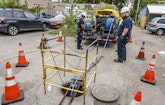
Matt Wagner, Bryant Bailey and Dan Bokrors (from left) of BLD Services prepare to line a junction of a residential sewer lateral for the Columbus Department of Public Utilities, part of a program to address inflow and infiltration from private properties.
Photography by James DeCamp
The story’s familiar: The EPA issues consent decrees to a municipality for sanitary and combined sewer overflows, forcing rehabilitation of existing underground infrastructure to protect the public and environment from raw sewage spills. The city of Columbus, Ohio, is no...








